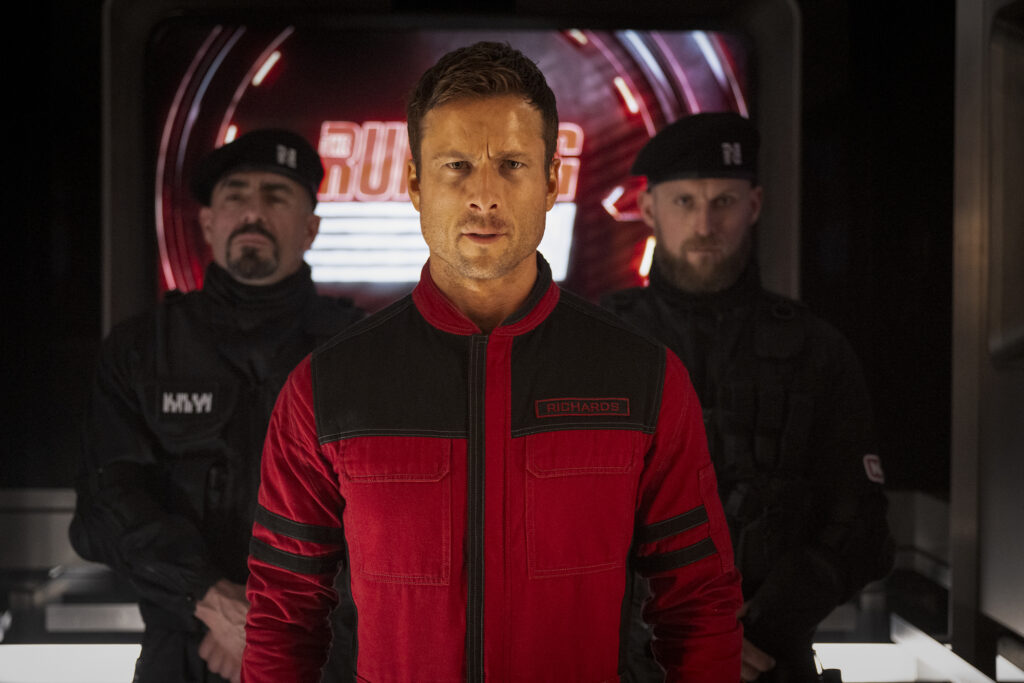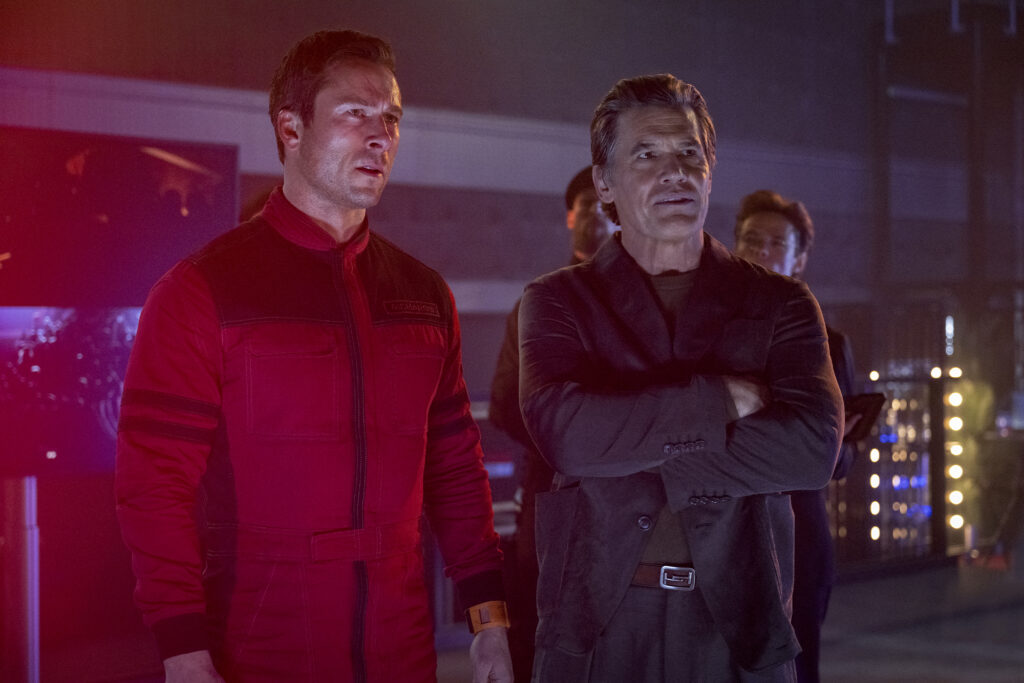Glen Powell isn’t looking for comfort — he’s looking for the roles that scare the shit out of him. And for his leading turn as Ben Richards in Edgar Wright’s highly anticipated The Running Man, the SHARP cover alum didn’t just find fear; he found a thrilling, two-fold challenge: diving into a character fuelled by raw rage and subjecting himself to an intense physical gauntlet. The result is a visceral, no-shortcuts action spectacle that is truly meant for the big screen.
“I’ve had a lot of people that have tried to push me down. I hate a bully. It’s definitely my trigger as a person. And really, that’s what Ben Richards hates the most as well.”
Glen Powell
Powell lives by an unconventional career philosophy: if a role feels too safe, then it’s probably wrong. When Ben Richards came calling, it was an immediate “yes”, precisely because it forced him to inhabit a persona drastically different from his own.
“He’s a guy with a short fuse… his superpower, as I say, is his anger,” Powell explained in an interview with SHARP. For the actor, who describes himself as a patient and steady person, this was an emotional challenge. Yet, everyone has a trigger, and for Powell, it’s bullies.

“We all have fire in our belly and I’ve been doing this a long time. I’ve had a lot of people that have tried to push me down. I hate a bully. It’s definitely my trigger as a person. And really, that’s what Ben Richards hates the most as well.”
The role allowed Powell to access and channel an aspect of himself that he usually keeps firmly under control. He loved playing a character who doesn’t hold his tongue — or his punches.
The Running Man star continued, “I’m mindful in a world sometimes that’s determined to get reactions out of me. I’m a pretty patient person. I tend to be steady as a rock. Even though you want to unleash, even though you want to show a different side, sometimes, you just grit your teeth and you just smile through it. But it’s pretty fun to be in Ben Richards’ shoes — a guy who really lets his anger fly pretty quickly.”
Beyond the emotional release, the movie required a level of physical commitment Powell hadn’t experienced before. It’s certainly a new vehicle to showcase his talents as an action hero. “I’d never been out in front of an action movie before. I’ve gotten to be a part of some big action films, but haven’t really been in [something like this.]”

“You’re in Ben Richards’ perspective this entire movie,” he says. “Life and death is around every corner. The physical gauntlet that I knew I’d have to go through was a really wild and challenging thought. So I was really excited to take on that challenge as well.”
If the movie feels earned on the big screen, it’s because Powell and director Edgar Wright made a crucial commitment at the outset: “No shortcuts.”
The actor is a firm believer that the audience knows when a performance is real, and that authenticity is critical for a truly thrilling experience. “I do believe that there is a big difference in the way an audience receives a movie when you’re doing it yourself,” Powell states, referencing the undeniable G-forces he experienced filming Top Gun: Maverick.
“It’s always fulfilling to go, ‘Okay, it’s gonna be a little uncomfortable, but this is a piece I gotta show and give to an audience.'”
Glen Powell
For The Running Man, Powell insisted on absorbing the real abuse, running from real explosions, and performing the high-octane sequences himself to ensure the “magic trick” felt visceral and compelling.
“There were times in which I would do certain stunts, and then I’d literally look at playback and I’m like, ‘Edgar, that could be anyone.’ Like, ‘Please, if I’m getting my ass kicked here, man, at least show my face please. Can we just have a leg a little over here?’” he laughed.
The commitment was that, if he was icing his body down at the end of every day, the audience needed to know who they were cheering for.

Powell is meticulous about his craft, carrying a book where he records every lesson learned from his collaborators. For his transition into a modern action icon, the most valuable advice came from his Maverick mentor, Tom Cruise. Cruise’s wisdom? “Just make myself bulletproof.”
“[Cruise] said, ‘You’re going to be taking a lot of abuse in an action movie.’ People think that because it’s choreographed, that’s not painful. But, if you’re taking a kick, you’re still absorbing a kick, right? It still hurts. If somebody’s stepping on your throat, it still sucks. If you’re running in an explosion, there’s still debris. It’s still dangerous. If you’re hanging from the side of a building, you’re one thread away from your own death and everybody’s aware of it. So I think for me, just the training process. Tom really gave me a lot of shortcuts to make sure that I really survived the shoot,” he said.
Reflecting on the whole experience, the intensity of The Running Man led Powell to his own artistic discovery. The role demanded he tap into “ugly places” and “channel some things that aren’t comfortable, that aren’t necessarily fun, but are pieces of me that you don’t get to show all the time.”

Ultimately, this emotional discomfort became a source of great satisfaction. “It’s always fulfilling to go, ‘Okay, it’s gonna be a little uncomfortable, but this is a piece I gotta show and give to an audience,'” he reflects.
Powell utilizes a highly mindful and imaginative technique for selecting and approaching his roles, a process he credits to producer Jerry Bruckheimer. His method involves an intense visualization exercise: before committing to a project or even finishing a script, Powell will close his eyes and “watch the movie” in his head from an audience perspective. He critically assesses various outcomes, imagining “What’s the good version of this movie? What’s the bad version of this movie?” and determining how he can best occupy the role and ensure deep audience engagement. This visualization helps him pinpoint the character’s defining attribute, as he did with Ben Richards, whose “superpower is anger.”
It’s clear that in The Running Man, Powell’s challenge was to unleash his inner fire and become the adrenaline-soaked hero today’s generation is ready to root for.
The Running Man is in theatres Friday.
FEATURE PHOTO BY LORENZO AGIUS.



